Business Environment: Organizational Types and Analysis
VerifiedAdded on 2020/11/23
|19
|5737
|318
Report
AI Summary
This report delves into the complexities of the business environment, examining the different types of organizations including public, private, and voluntary sectors, and their legal structures. It explores the size and scope of these organizations, linking them to their objectives and products. The report analyzes the interrelationships between organizational functions like marketing, finance, and human resources, and how they contribute to achieving organizational goals. Furthermore, it investigates the positive and negative impacts of the macro environment, using Marks & Spencer as a case study, and employs the PESTLE and SWOT models to analyze external factors. The analysis covers the impact of both macro and micro factors on business decision-making, providing a comprehensive overview of the challenges and opportunities within the business landscape.
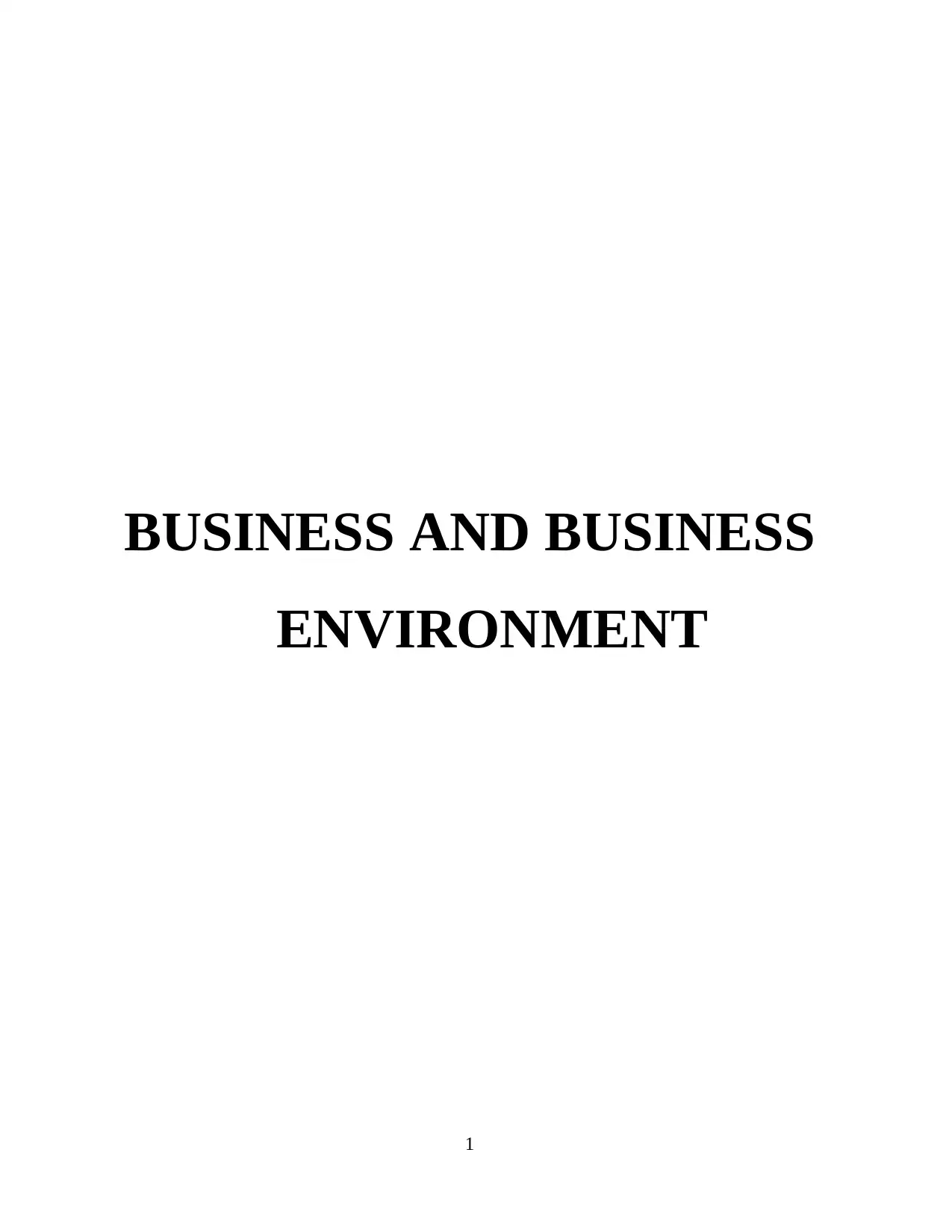
BUSINESS AND BUSINESS
ENVIRONMENT
1
ENVIRONMENT
1
Paraphrase This Document
Need a fresh take? Get an instant paraphrase of this document with our AI Paraphraser
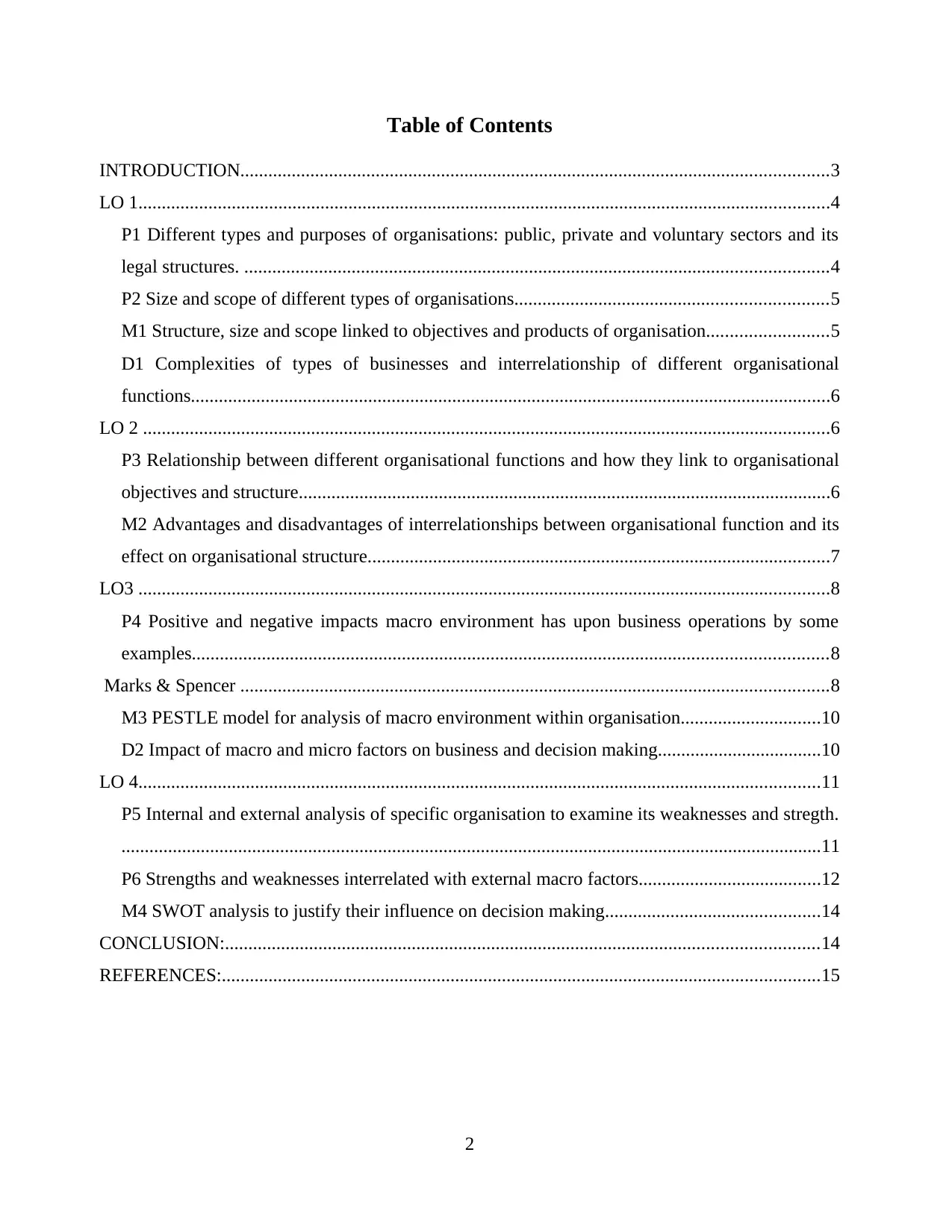
Table of Contents
INTRODUCTION..............................................................................................................................3
LO 1....................................................................................................................................................4
P1 Different types and purposes of organisations: public, private and voluntary sectors and its
legal structures. .............................................................................................................................4
P2 Size and scope of different types of organisations...................................................................5
M1 Structure, size and scope linked to objectives and products of organisation..........................5
D1 Complexities of types of businesses and interrelationship of different organisational
functions.........................................................................................................................................6
LO 2 ...................................................................................................................................................6
P3 Relationship between different organisational functions and how they link to organisational
objectives and structure..................................................................................................................6
M2 Advantages and disadvantages of interrelationships between organisational function and its
effect on organisational structure...................................................................................................7
LO3 ....................................................................................................................................................8
P4 Positive and negative impacts macro environment has upon business operations by some
examples........................................................................................................................................8
Marks & Spencer ..............................................................................................................................8
M3 PESTLE model for analysis of macro environment within organisation..............................10
D2 Impact of macro and micro factors on business and decision making...................................10
LO 4..................................................................................................................................................11
P5 Internal and external analysis of specific organisation to examine its weaknesses and stregth.
......................................................................................................................................................11
P6 Strengths and weaknesses interrelated with external macro factors.......................................12
M4 SWOT analysis to justify their influence on decision making..............................................14
CONCLUSION:...............................................................................................................................14
REFERENCES:................................................................................................................................15
2
INTRODUCTION..............................................................................................................................3
LO 1....................................................................................................................................................4
P1 Different types and purposes of organisations: public, private and voluntary sectors and its
legal structures. .............................................................................................................................4
P2 Size and scope of different types of organisations...................................................................5
M1 Structure, size and scope linked to objectives and products of organisation..........................5
D1 Complexities of types of businesses and interrelationship of different organisational
functions.........................................................................................................................................6
LO 2 ...................................................................................................................................................6
P3 Relationship between different organisational functions and how they link to organisational
objectives and structure..................................................................................................................6
M2 Advantages and disadvantages of interrelationships between organisational function and its
effect on organisational structure...................................................................................................7
LO3 ....................................................................................................................................................8
P4 Positive and negative impacts macro environment has upon business operations by some
examples........................................................................................................................................8
Marks & Spencer ..............................................................................................................................8
M3 PESTLE model for analysis of macro environment within organisation..............................10
D2 Impact of macro and micro factors on business and decision making...................................10
LO 4..................................................................................................................................................11
P5 Internal and external analysis of specific organisation to examine its weaknesses and stregth.
......................................................................................................................................................11
P6 Strengths and weaknesses interrelated with external macro factors.......................................12
M4 SWOT analysis to justify their influence on decision making..............................................14
CONCLUSION:...............................................................................................................................14
REFERENCES:................................................................................................................................15
2
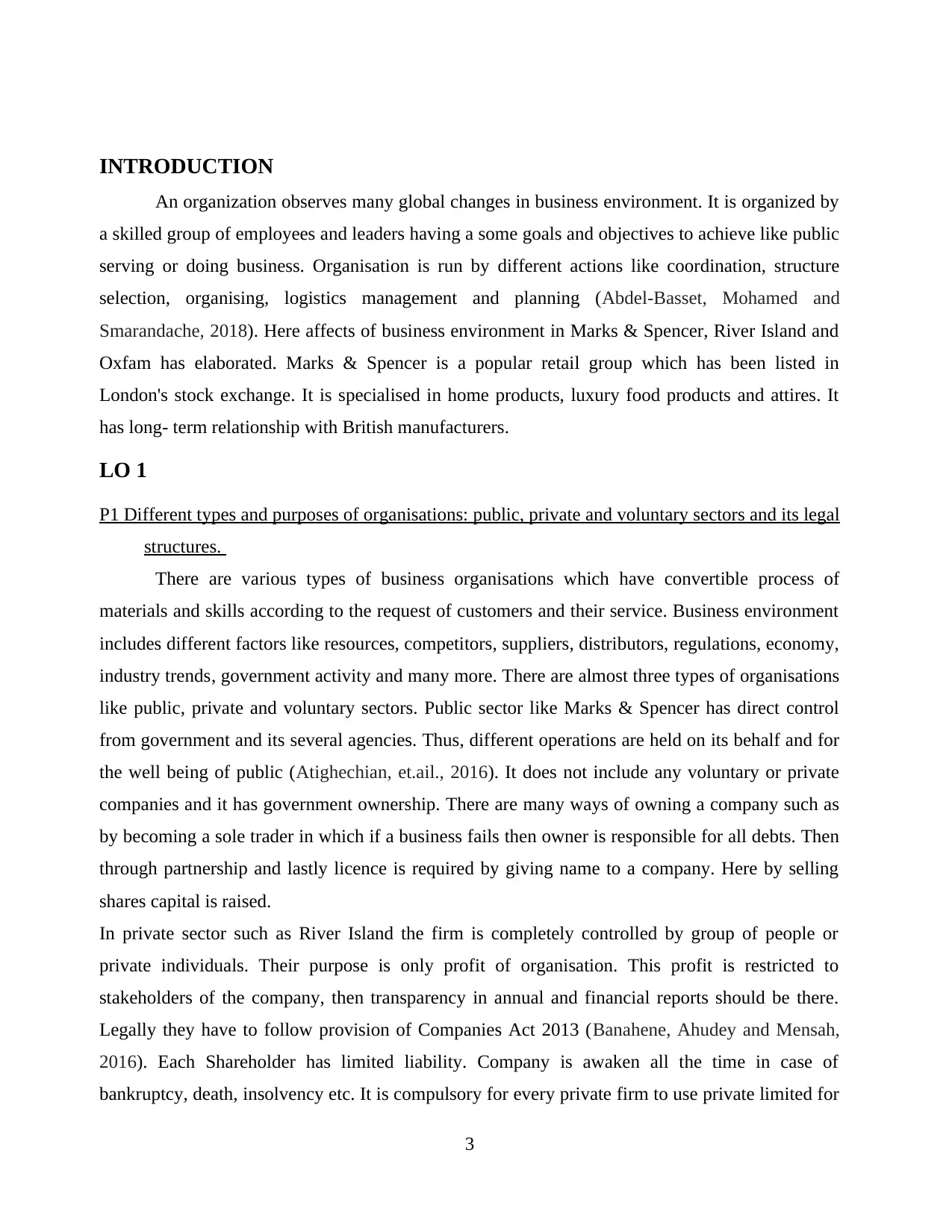
INTRODUCTION
An organization observes many global changes in business environment. It is organized by
a skilled group of employees and leaders having a some goals and objectives to achieve like public
serving or doing business. Organisation is run by different actions like coordination, structure
selection, organising, logistics management and planning (Abdel-Basset, Mohamed and
Smarandache, 2018). Here affects of business environment in Marks & Spencer, River Island and
Oxfam has elaborated. Marks & Spencer is a popular retail group which has been listed in
London's stock exchange. It is specialised in home products, luxury food products and attires. It
has long- term relationship with British manufacturers.
LO 1
P1 Different types and purposes of organisations: public, private and voluntary sectors and its legal
structures.
There are various types of business organisations which have convertible process of
materials and skills according to the request of customers and their service. Business environment
includes different factors like resources, competitors, suppliers, distributors, regulations, economy,
industry trends, government activity and many more. There are almost three types of organisations
like public, private and voluntary sectors. Public sector like Marks & Spencer has direct control
from government and its several agencies. Thus, different operations are held on its behalf and for
the well being of public (Atighechian, et.ail., 2016). It does not include any voluntary or private
companies and it has government ownership. There are many ways of owning a company such as
by becoming a sole trader in which if a business fails then owner is responsible for all debts. Then
through partnership and lastly licence is required by giving name to a company. Here by selling
shares capital is raised.
In private sector such as River Island the firm is completely controlled by group of people or
private individuals. Their purpose is only profit of organisation. This profit is restricted to
stakeholders of the company, then transparency in annual and financial reports should be there.
Legally they have to follow provision of Companies Act 2013 (Banahene, Ahudey and Mensah,
2016). Each Shareholder has limited liability. Company is awaken all the time in case of
bankruptcy, death, insolvency etc. It is compulsory for every private firm to use private limited for
3
An organization observes many global changes in business environment. It is organized by
a skilled group of employees and leaders having a some goals and objectives to achieve like public
serving or doing business. Organisation is run by different actions like coordination, structure
selection, organising, logistics management and planning (Abdel-Basset, Mohamed and
Smarandache, 2018). Here affects of business environment in Marks & Spencer, River Island and
Oxfam has elaborated. Marks & Spencer is a popular retail group which has been listed in
London's stock exchange. It is specialised in home products, luxury food products and attires. It
has long- term relationship with British manufacturers.
LO 1
P1 Different types and purposes of organisations: public, private and voluntary sectors and its legal
structures.
There are various types of business organisations which have convertible process of
materials and skills according to the request of customers and their service. Business environment
includes different factors like resources, competitors, suppliers, distributors, regulations, economy,
industry trends, government activity and many more. There are almost three types of organisations
like public, private and voluntary sectors. Public sector like Marks & Spencer has direct control
from government and its several agencies. Thus, different operations are held on its behalf and for
the well being of public (Atighechian, et.ail., 2016). It does not include any voluntary or private
companies and it has government ownership. There are many ways of owning a company such as
by becoming a sole trader in which if a business fails then owner is responsible for all debts. Then
through partnership and lastly licence is required by giving name to a company. Here by selling
shares capital is raised.
In private sector such as River Island the firm is completely controlled by group of people or
private individuals. Their purpose is only profit of organisation. This profit is restricted to
stakeholders of the company, then transparency in annual and financial reports should be there.
Legally they have to follow provision of Companies Act 2013 (Banahene, Ahudey and Mensah,
2016). Each Shareholder has limited liability. Company is awaken all the time in case of
bankruptcy, death, insolvency etc. It is compulsory for every private firm to use private limited for
3
⊘ This is a preview!⊘
Do you want full access?
Subscribe today to unlock all pages.

Trusted by 1+ million students worldwide
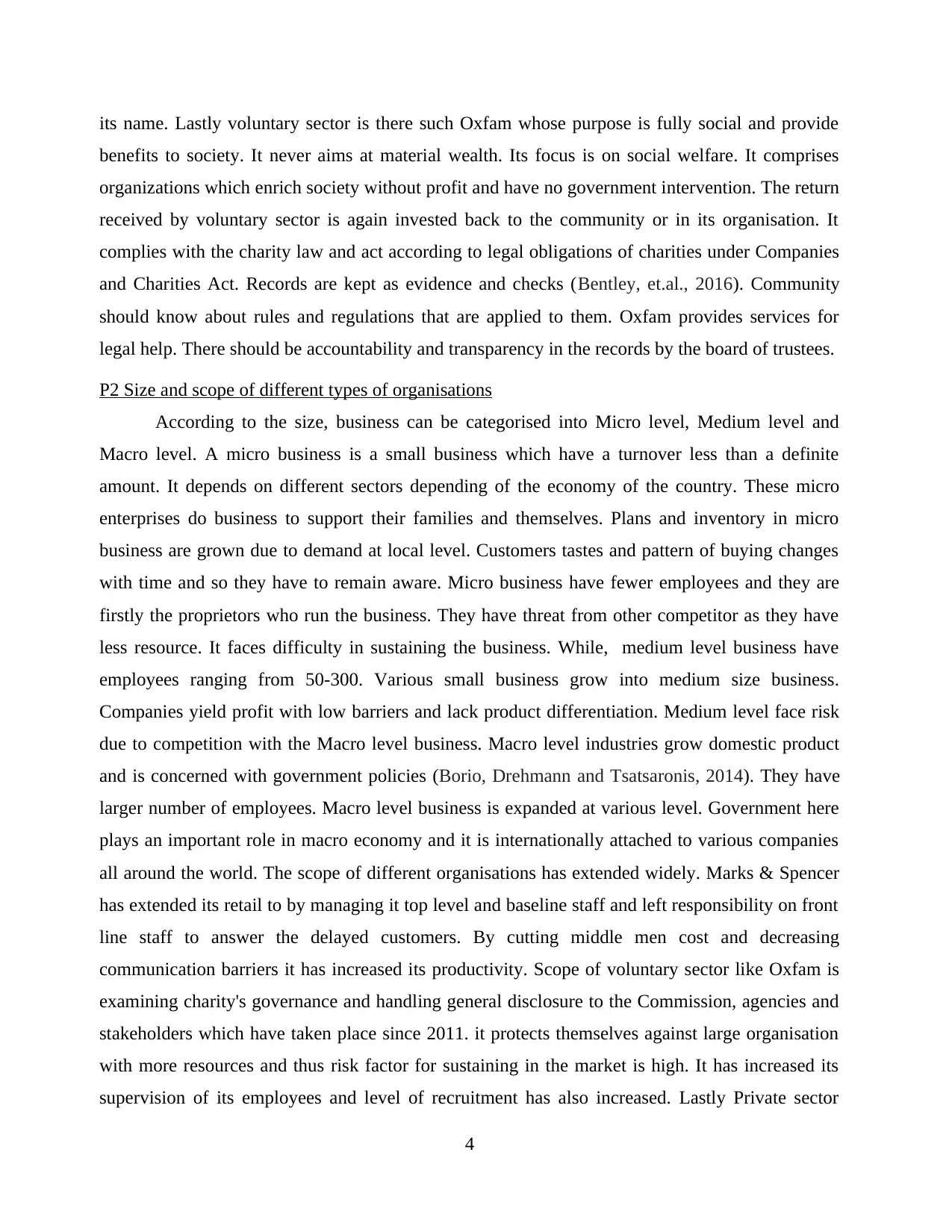
its name. Lastly voluntary sector is there such Oxfam whose purpose is fully social and provide
benefits to society. It never aims at material wealth. Its focus is on social welfare. It comprises
organizations which enrich society without profit and have no government intervention. The return
received by voluntary sector is again invested back to the community or in its organisation. It
complies with the charity law and act according to legal obligations of charities under Companies
and Charities Act. Records are kept as evidence and checks (Bentley, et.al., 2016). Community
should know about rules and regulations that are applied to them. Oxfam provides services for
legal help. There should be accountability and transparency in the records by the board of trustees.
P2 Size and scope of different types of organisations
According to the size, business can be categorised into Micro level, Medium level and
Macro level. A micro business is a small business which have a turnover less than a definite
amount. It depends on different sectors depending of the economy of the country. These micro
enterprises do business to support their families and themselves. Plans and inventory in micro
business are grown due to demand at local level. Customers tastes and pattern of buying changes
with time and so they have to remain aware. Micro business have fewer employees and they are
firstly the proprietors who run the business. They have threat from other competitor as they have
less resource. It faces difficulty in sustaining the business. While, medium level business have
employees ranging from 50-300. Various small business grow into medium size business.
Companies yield profit with low barriers and lack product differentiation. Medium level face risk
due to competition with the Macro level business. Macro level industries grow domestic product
and is concerned with government policies (Borio, Drehmann and Tsatsaronis, 2014). They have
larger number of employees. Macro level business is expanded at various level. Government here
plays an important role in macro economy and it is internationally attached to various companies
all around the world. The scope of different organisations has extended widely. Marks & Spencer
has extended its retail to by managing it top level and baseline staff and left responsibility on front
line staff to answer the delayed customers. By cutting middle men cost and decreasing
communication barriers it has increased its productivity. Scope of voluntary sector like Oxfam is
examining charity's governance and handling general disclosure to the Commission, agencies and
stakeholders which have taken place since 2011. it protects themselves against large organisation
with more resources and thus risk factor for sustaining in the market is high. It has increased its
supervision of its employees and level of recruitment has also increased. Lastly Private sector
4
benefits to society. It never aims at material wealth. Its focus is on social welfare. It comprises
organizations which enrich society without profit and have no government intervention. The return
received by voluntary sector is again invested back to the community or in its organisation. It
complies with the charity law and act according to legal obligations of charities under Companies
and Charities Act. Records are kept as evidence and checks (Bentley, et.al., 2016). Community
should know about rules and regulations that are applied to them. Oxfam provides services for
legal help. There should be accountability and transparency in the records by the board of trustees.
P2 Size and scope of different types of organisations
According to the size, business can be categorised into Micro level, Medium level and
Macro level. A micro business is a small business which have a turnover less than a definite
amount. It depends on different sectors depending of the economy of the country. These micro
enterprises do business to support their families and themselves. Plans and inventory in micro
business are grown due to demand at local level. Customers tastes and pattern of buying changes
with time and so they have to remain aware. Micro business have fewer employees and they are
firstly the proprietors who run the business. They have threat from other competitor as they have
less resource. It faces difficulty in sustaining the business. While, medium level business have
employees ranging from 50-300. Various small business grow into medium size business.
Companies yield profit with low barriers and lack product differentiation. Medium level face risk
due to competition with the Macro level business. Macro level industries grow domestic product
and is concerned with government policies (Borio, Drehmann and Tsatsaronis, 2014). They have
larger number of employees. Macro level business is expanded at various level. Government here
plays an important role in macro economy and it is internationally attached to various companies
all around the world. The scope of different organisations has extended widely. Marks & Spencer
has extended its retail to by managing it top level and baseline staff and left responsibility on front
line staff to answer the delayed customers. By cutting middle men cost and decreasing
communication barriers it has increased its productivity. Scope of voluntary sector like Oxfam is
examining charity's governance and handling general disclosure to the Commission, agencies and
stakeholders which have taken place since 2011. it protects themselves against large organisation
with more resources and thus risk factor for sustaining in the market is high. It has increased its
supervision of its employees and level of recruitment has also increased. Lastly Private sector
4
Paraphrase This Document
Need a fresh take? Get an instant paraphrase of this document with our AI Paraphraser
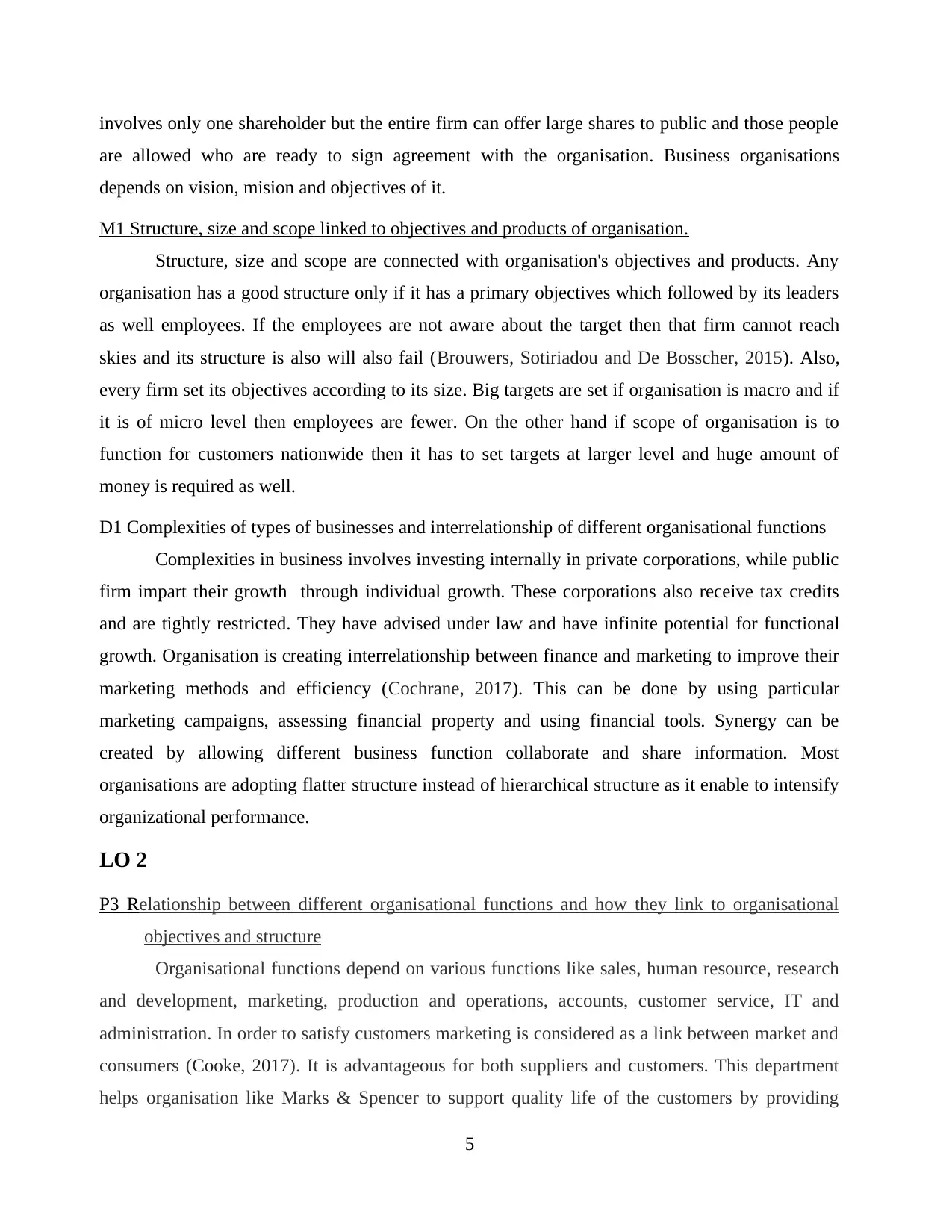
involves only one shareholder but the entire firm can offer large shares to public and those people
are allowed who are ready to sign agreement with the organisation. Business organisations
depends on vision, mision and objectives of it.
M1 Structure, size and scope linked to objectives and products of organisation.
Structure, size and scope are connected with organisation's objectives and products. Any
organisation has a good structure only if it has a primary objectives which followed by its leaders
as well employees. If the employees are not aware about the target then that firm cannot reach
skies and its structure is also will also fail (Brouwers, Sotiriadou and De Bosscher, 2015). Also,
every firm set its objectives according to its size. Big targets are set if organisation is macro and if
it is of micro level then employees are fewer. On the other hand if scope of organisation is to
function for customers nationwide then it has to set targets at larger level and huge amount of
money is required as well.
D1 Complexities of types of businesses and interrelationship of different organisational functions
Complexities in business involves investing internally in private corporations, while public
firm impart their growth through individual growth. These corporations also receive tax credits
and are tightly restricted. They have advised under law and have infinite potential for functional
growth. Organisation is creating interrelationship between finance and marketing to improve their
marketing methods and efficiency (Cochrane, 2017). This can be done by using particular
marketing campaigns, assessing financial property and using financial tools. Synergy can be
created by allowing different business function collaborate and share information. Most
organisations are adopting flatter structure instead of hierarchical structure as it enable to intensify
organizational performance.
LO 2
P3 Relationship between different organisational functions and how they link to organisational
objectives and structure
Organisational functions depend on various functions like sales, human resource, research
and development, marketing, production and operations, accounts, customer service, IT and
administration. In order to satisfy customers marketing is considered as a link between market and
consumers (Cooke, 2017). It is advantageous for both suppliers and customers. This department
helps organisation like Marks & Spencer to support quality life of the customers by providing
5
are allowed who are ready to sign agreement with the organisation. Business organisations
depends on vision, mision and objectives of it.
M1 Structure, size and scope linked to objectives and products of organisation.
Structure, size and scope are connected with organisation's objectives and products. Any
organisation has a good structure only if it has a primary objectives which followed by its leaders
as well employees. If the employees are not aware about the target then that firm cannot reach
skies and its structure is also will also fail (Brouwers, Sotiriadou and De Bosscher, 2015). Also,
every firm set its objectives according to its size. Big targets are set if organisation is macro and if
it is of micro level then employees are fewer. On the other hand if scope of organisation is to
function for customers nationwide then it has to set targets at larger level and huge amount of
money is required as well.
D1 Complexities of types of businesses and interrelationship of different organisational functions
Complexities in business involves investing internally in private corporations, while public
firm impart their growth through individual growth. These corporations also receive tax credits
and are tightly restricted. They have advised under law and have infinite potential for functional
growth. Organisation is creating interrelationship between finance and marketing to improve their
marketing methods and efficiency (Cochrane, 2017). This can be done by using particular
marketing campaigns, assessing financial property and using financial tools. Synergy can be
created by allowing different business function collaborate and share information. Most
organisations are adopting flatter structure instead of hierarchical structure as it enable to intensify
organizational performance.
LO 2
P3 Relationship between different organisational functions and how they link to organisational
objectives and structure
Organisational functions depend on various functions like sales, human resource, research
and development, marketing, production and operations, accounts, customer service, IT and
administration. In order to satisfy customers marketing is considered as a link between market and
consumers (Cooke, 2017). It is advantageous for both suppliers and customers. This department
helps organisation like Marks & Spencer to support quality life of the customers by providing
5
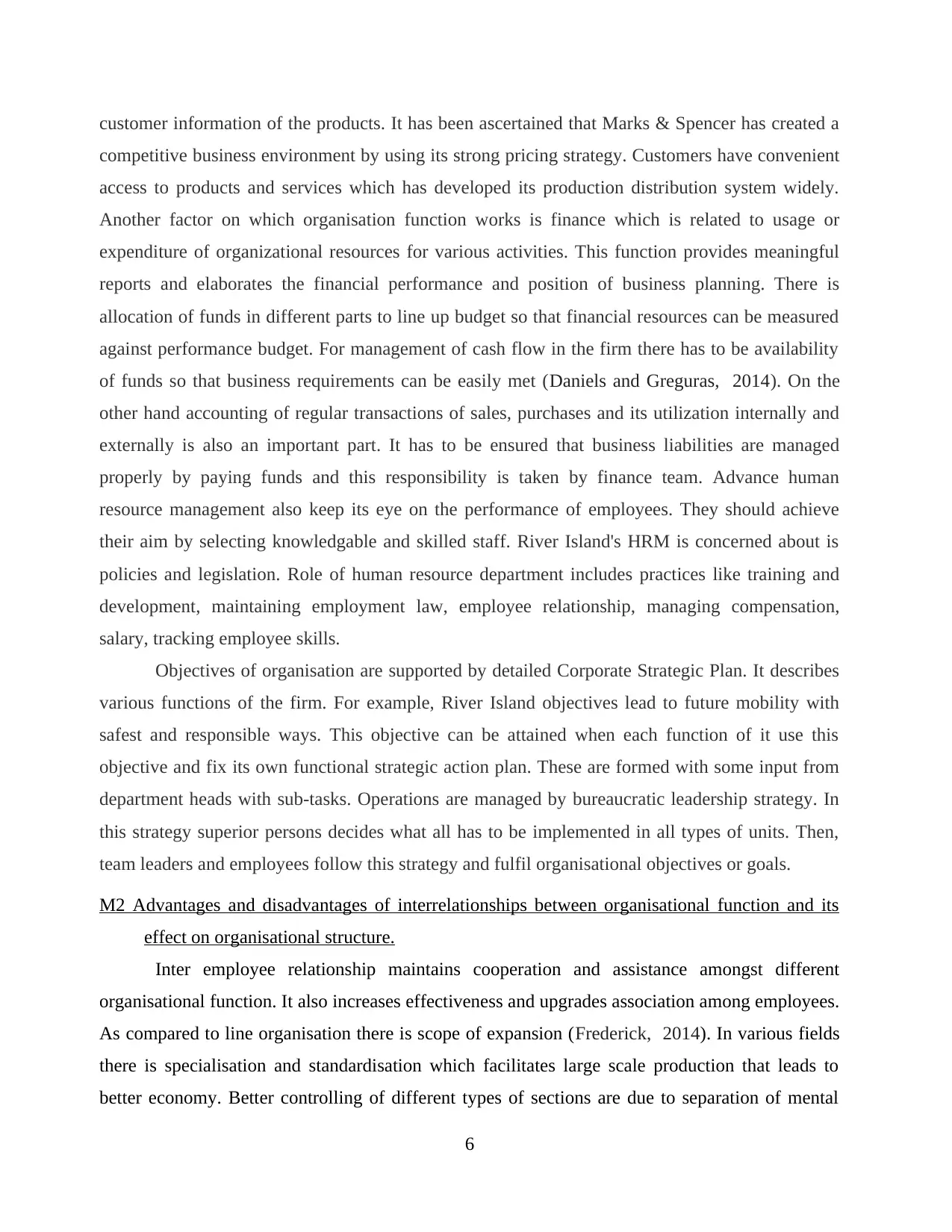
customer information of the products. It has been ascertained that Marks & Spencer has created a
competitive business environment by using its strong pricing strategy. Customers have convenient
access to products and services which has developed its production distribution system widely.
Another factor on which organisation function works is finance which is related to usage or
expenditure of organizational resources for various activities. This function provides meaningful
reports and elaborates the financial performance and position of business planning. There is
allocation of funds in different parts to line up budget so that financial resources can be measured
against performance budget. For management of cash flow in the firm there has to be availability
of funds so that business requirements can be easily met (Daniels and Greguras, 2014). On the
other hand accounting of regular transactions of sales, purchases and its utilization internally and
externally is also an important part. It has to be ensured that business liabilities are managed
properly by paying funds and this responsibility is taken by finance team. Advance human
resource management also keep its eye on the performance of employees. They should achieve
their aim by selecting knowledgable and skilled staff. River Island's HRM is concerned about is
policies and legislation. Role of human resource department includes practices like training and
development, maintaining employment law, employee relationship, managing compensation,
salary, tracking employee skills.
Objectives of organisation are supported by detailed Corporate Strategic Plan. It describes
various functions of the firm. For example, River Island objectives lead to future mobility with
safest and responsible ways. This objective can be attained when each function of it use this
objective and fix its own functional strategic action plan. These are formed with some input from
department heads with sub-tasks. Operations are managed by bureaucratic leadership strategy. In
this strategy superior persons decides what all has to be implemented in all types of units. Then,
team leaders and employees follow this strategy and fulfil organisational objectives or goals.
M2 Advantages and disadvantages of interrelationships between organisational function and its
effect on organisational structure.
Inter employee relationship maintains cooperation and assistance amongst different
organisational function. It also increases effectiveness and upgrades association among employees.
As compared to line organisation there is scope of expansion (Frederick, 2014). In various fields
there is specialisation and standardisation which facilitates large scale production that leads to
better economy. Better controlling of different types of sections are due to separation of mental
6
competitive business environment by using its strong pricing strategy. Customers have convenient
access to products and services which has developed its production distribution system widely.
Another factor on which organisation function works is finance which is related to usage or
expenditure of organizational resources for various activities. This function provides meaningful
reports and elaborates the financial performance and position of business planning. There is
allocation of funds in different parts to line up budget so that financial resources can be measured
against performance budget. For management of cash flow in the firm there has to be availability
of funds so that business requirements can be easily met (Daniels and Greguras, 2014). On the
other hand accounting of regular transactions of sales, purchases and its utilization internally and
externally is also an important part. It has to be ensured that business liabilities are managed
properly by paying funds and this responsibility is taken by finance team. Advance human
resource management also keep its eye on the performance of employees. They should achieve
their aim by selecting knowledgable and skilled staff. River Island's HRM is concerned about is
policies and legislation. Role of human resource department includes practices like training and
development, maintaining employment law, employee relationship, managing compensation,
salary, tracking employee skills.
Objectives of organisation are supported by detailed Corporate Strategic Plan. It describes
various functions of the firm. For example, River Island objectives lead to future mobility with
safest and responsible ways. This objective can be attained when each function of it use this
objective and fix its own functional strategic action plan. These are formed with some input from
department heads with sub-tasks. Operations are managed by bureaucratic leadership strategy. In
this strategy superior persons decides what all has to be implemented in all types of units. Then,
team leaders and employees follow this strategy and fulfil organisational objectives or goals.
M2 Advantages and disadvantages of interrelationships between organisational function and its
effect on organisational structure.
Inter employee relationship maintains cooperation and assistance amongst different
organisational function. It also increases effectiveness and upgrades association among employees.
As compared to line organisation there is scope of expansion (Frederick, 2014). In various fields
there is specialisation and standardisation which facilitates large scale production that leads to
better economy. Better controlling of different types of sections are due to separation of mental
6
⊘ This is a preview!⊘
Do you want full access?
Subscribe today to unlock all pages.

Trusted by 1+ million students worldwide
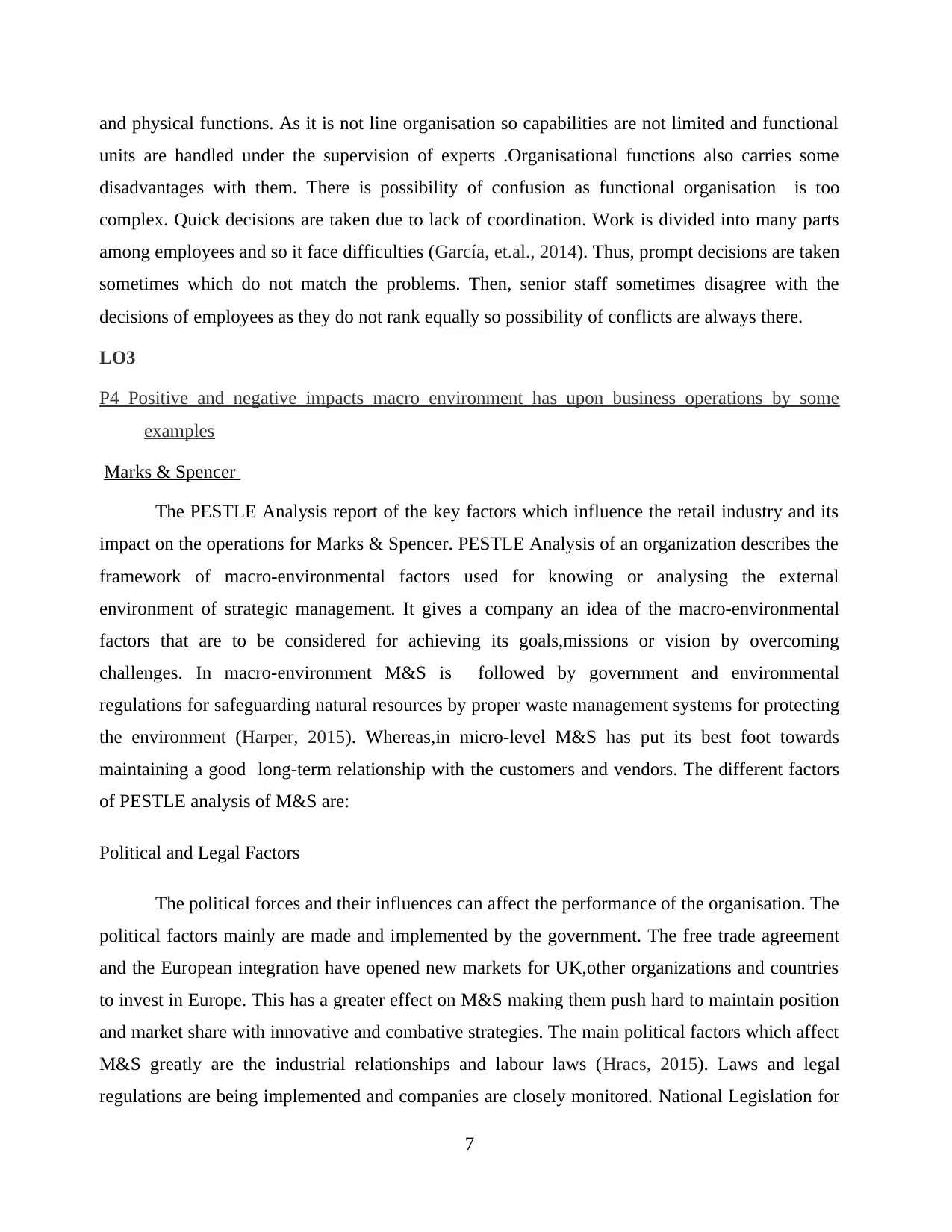
and physical functions. As it is not line organisation so capabilities are not limited and functional
units are handled under the supervision of experts .Organisational functions also carries some
disadvantages with them. There is possibility of confusion as functional organisation is too
complex. Quick decisions are taken due to lack of coordination. Work is divided into many parts
among employees and so it face difficulties (García, et.al., 2014). Thus, prompt decisions are taken
sometimes which do not match the problems. Then, senior staff sometimes disagree with the
decisions of employees as they do not rank equally so possibility of conflicts are always there.
LO3
P4 Positive and negative impacts macro environment has upon business operations by some
examples
Marks & Spencer
The PESTLE Analysis report of the key factors which influence the retail industry and its
impact on the operations for Marks & Spencer. PESTLE Analysis of an organization describes the
framework of macro-environmental factors used for knowing or analysing the external
environment of strategic management. It gives a company an idea of the macro-environmental
factors that are to be considered for achieving its goals,missions or vision by overcoming
challenges. In macro-environment M&S is followed by government and environmental
regulations for safeguarding natural resources by proper waste management systems for protecting
the environment (Harper, 2015). Whereas,in micro-level M&S has put its best foot towards
maintaining a good long-term relationship with the customers and vendors. The different factors
of PESTLE analysis of M&S are:
Political and Legal Factors
The political forces and their influences can affect the performance of the organisation. The
political factors mainly are made and implemented by the government. The free trade agreement
and the European integration have opened new markets for UK,other organizations and countries
to invest in Europe. This has a greater effect on M&S making them push hard to maintain position
and market share with innovative and combative strategies. The main political factors which affect
M&S greatly are the industrial relationships and labour laws (Hracs, 2015). Laws and legal
regulations are being implemented and companies are closely monitored. National Legislation for
7
units are handled under the supervision of experts .Organisational functions also carries some
disadvantages with them. There is possibility of confusion as functional organisation is too
complex. Quick decisions are taken due to lack of coordination. Work is divided into many parts
among employees and so it face difficulties (García, et.al., 2014). Thus, prompt decisions are taken
sometimes which do not match the problems. Then, senior staff sometimes disagree with the
decisions of employees as they do not rank equally so possibility of conflicts are always there.
LO3
P4 Positive and negative impacts macro environment has upon business operations by some
examples
Marks & Spencer
The PESTLE Analysis report of the key factors which influence the retail industry and its
impact on the operations for Marks & Spencer. PESTLE Analysis of an organization describes the
framework of macro-environmental factors used for knowing or analysing the external
environment of strategic management. It gives a company an idea of the macro-environmental
factors that are to be considered for achieving its goals,missions or vision by overcoming
challenges. In macro-environment M&S is followed by government and environmental
regulations for safeguarding natural resources by proper waste management systems for protecting
the environment (Harper, 2015). Whereas,in micro-level M&S has put its best foot towards
maintaining a good long-term relationship with the customers and vendors. The different factors
of PESTLE analysis of M&S are:
Political and Legal Factors
The political forces and their influences can affect the performance of the organisation. The
political factors mainly are made and implemented by the government. The free trade agreement
and the European integration have opened new markets for UK,other organizations and countries
to invest in Europe. This has a greater effect on M&S making them push hard to maintain position
and market share with innovative and combative strategies. The main political factors which affect
M&S greatly are the industrial relationships and labour laws (Hracs, 2015). Laws and legal
regulations are being implemented and companies are closely monitored. National Legislation for
7
Paraphrase This Document
Need a fresh take? Get an instant paraphrase of this document with our AI Paraphraser
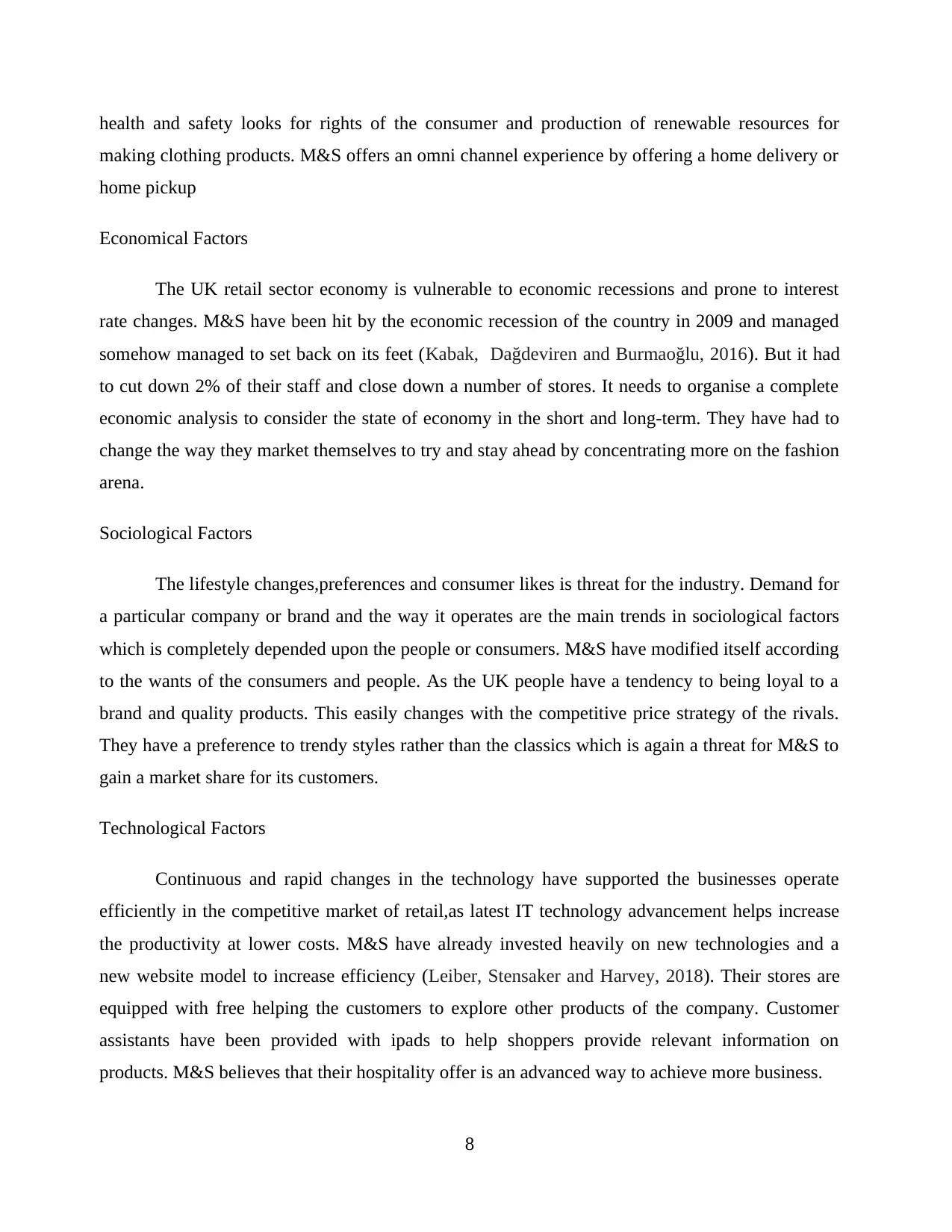
health and safety looks for rights of the consumer and production of renewable resources for
making clothing products. M&S offers an omni channel experience by offering a home delivery or
home pickup
Economical Factors
The UK retail sector economy is vulnerable to economic recessions and prone to interest
rate changes. M&S have been hit by the economic recession of the country in 2009 and managed
somehow managed to set back on its feet (Kabak, Dağdeviren and Burmaoğlu, 2016). But it had
to cut down 2% of their staff and close down a number of stores. It needs to organise a complete
economic analysis to consider the state of economy in the short and long-term. They have had to
change the way they market themselves to try and stay ahead by concentrating more on the fashion
arena.
Sociological Factors
The lifestyle changes,preferences and consumer likes is threat for the industry. Demand for
a particular company or brand and the way it operates are the main trends in sociological factors
which is completely depended upon the people or consumers. M&S have modified itself according
to the wants of the consumers and people. As the UK people have a tendency to being loyal to a
brand and quality products. This easily changes with the competitive price strategy of the rivals.
They have a preference to trendy styles rather than the classics which is again a threat for M&S to
gain a market share for its customers.
Technological Factors
Continuous and rapid changes in the technology have supported the businesses operate
efficiently in the competitive market of retail,as latest IT technology advancement helps increase
the productivity at lower costs. M&S have already invested heavily on new technologies and a
new website model to increase efficiency (Leiber, Stensaker and Harvey, 2018). Their stores are
equipped with free helping the customers to explore other products of the company. Customer
assistants have been provided with ipads to help shoppers provide relevant information on
products. M&S believes that their hospitality offer is an advanced way to achieve more business.
8
making clothing products. M&S offers an omni channel experience by offering a home delivery or
home pickup
Economical Factors
The UK retail sector economy is vulnerable to economic recessions and prone to interest
rate changes. M&S have been hit by the economic recession of the country in 2009 and managed
somehow managed to set back on its feet (Kabak, Dağdeviren and Burmaoğlu, 2016). But it had
to cut down 2% of their staff and close down a number of stores. It needs to organise a complete
economic analysis to consider the state of economy in the short and long-term. They have had to
change the way they market themselves to try and stay ahead by concentrating more on the fashion
arena.
Sociological Factors
The lifestyle changes,preferences and consumer likes is threat for the industry. Demand for
a particular company or brand and the way it operates are the main trends in sociological factors
which is completely depended upon the people or consumers. M&S have modified itself according
to the wants of the consumers and people. As the UK people have a tendency to being loyal to a
brand and quality products. This easily changes with the competitive price strategy of the rivals.
They have a preference to trendy styles rather than the classics which is again a threat for M&S to
gain a market share for its customers.
Technological Factors
Continuous and rapid changes in the technology have supported the businesses operate
efficiently in the competitive market of retail,as latest IT technology advancement helps increase
the productivity at lower costs. M&S have already invested heavily on new technologies and a
new website model to increase efficiency (Leiber, Stensaker and Harvey, 2018). Their stores are
equipped with free helping the customers to explore other products of the company. Customer
assistants have been provided with ipads to help shoppers provide relevant information on
products. M&S believes that their hospitality offer is an advanced way to achieve more business.
8
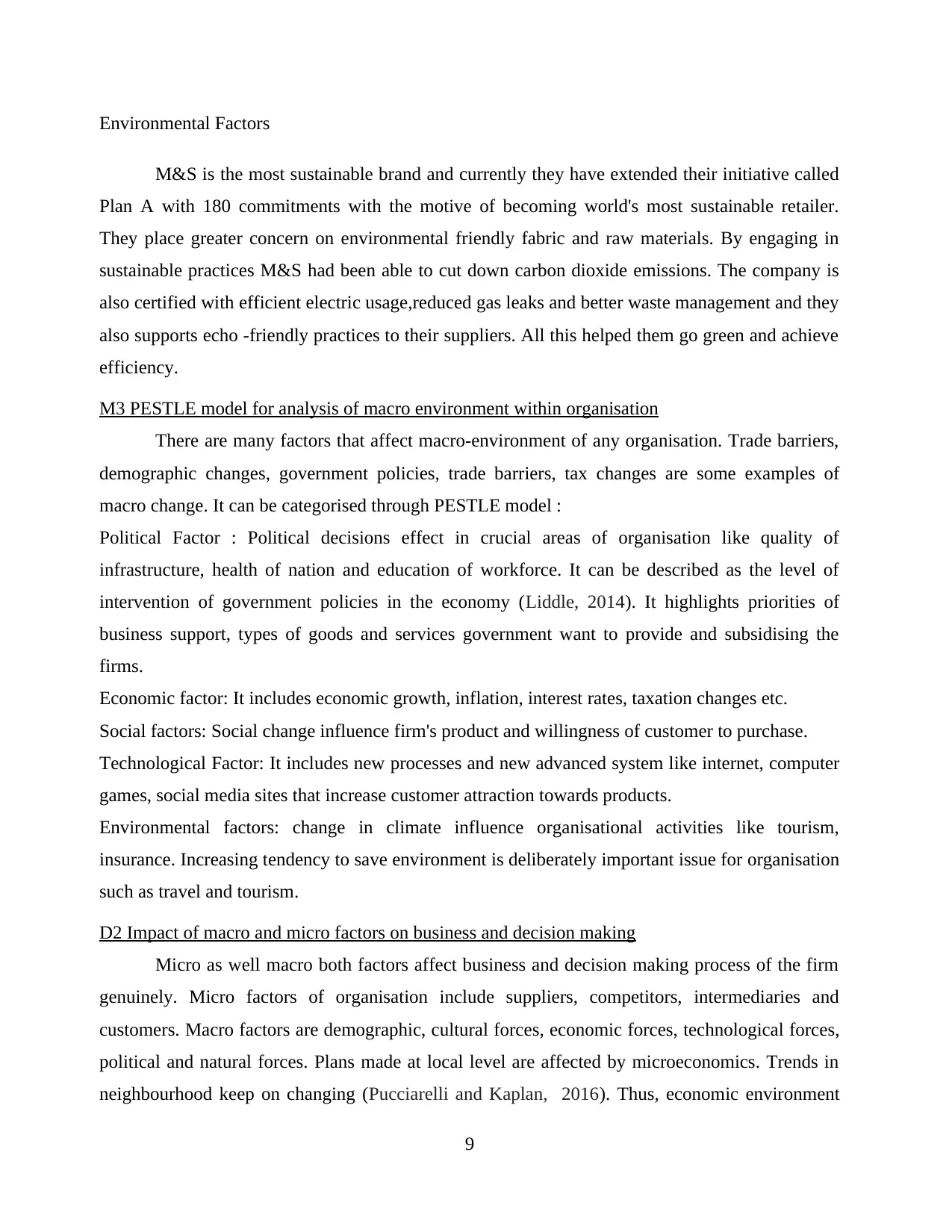
Environmental Factors
M&S is the most sustainable brand and currently they have extended their initiative called
Plan A with 180 commitments with the motive of becoming world's most sustainable retailer.
They place greater concern on environmental friendly fabric and raw materials. By engaging in
sustainable practices M&S had been able to cut down carbon dioxide emissions. The company is
also certified with efficient electric usage,reduced gas leaks and better waste management and they
also supports echo -friendly practices to their suppliers. All this helped them go green and achieve
efficiency.
M3 PESTLE model for analysis of macro environment within organisation
There are many factors that affect macro-environment of any organisation. Trade barriers,
demographic changes, government policies, trade barriers, tax changes are some examples of
macro change. It can be categorised through PESTLE model :
Political Factor : Political decisions effect in crucial areas of organisation like quality of
infrastructure, health of nation and education of workforce. It can be described as the level of
intervention of government policies in the economy (Liddle, 2014). It highlights priorities of
business support, types of goods and services government want to provide and subsidising the
firms.
Economic factor: It includes economic growth, inflation, interest rates, taxation changes etc.
Social factors: Social change influence firm's product and willingness of customer to purchase.
Technological Factor: It includes new processes and new advanced system like internet, computer
games, social media sites that increase customer attraction towards products.
Environmental factors: change in climate influence organisational activities like tourism,
insurance. Increasing tendency to save environment is deliberately important issue for organisation
such as travel and tourism.
D2 Impact of macro and micro factors on business and decision making
Micro as well macro both factors affect business and decision making process of the firm
genuinely. Micro factors of organisation include suppliers, competitors, intermediaries and
customers. Macro factors are demographic, cultural forces, economic forces, technological forces,
political and natural forces. Plans made at local level are affected by microeconomics. Trends in
neighbourhood keep on changing (Pucciarelli and Kaplan, 2016). Thus, economic environment
9
M&S is the most sustainable brand and currently they have extended their initiative called
Plan A with 180 commitments with the motive of becoming world's most sustainable retailer.
They place greater concern on environmental friendly fabric and raw materials. By engaging in
sustainable practices M&S had been able to cut down carbon dioxide emissions. The company is
also certified with efficient electric usage,reduced gas leaks and better waste management and they
also supports echo -friendly practices to their suppliers. All this helped them go green and achieve
efficiency.
M3 PESTLE model for analysis of macro environment within organisation
There are many factors that affect macro-environment of any organisation. Trade barriers,
demographic changes, government policies, trade barriers, tax changes are some examples of
macro change. It can be categorised through PESTLE model :
Political Factor : Political decisions effect in crucial areas of organisation like quality of
infrastructure, health of nation and education of workforce. It can be described as the level of
intervention of government policies in the economy (Liddle, 2014). It highlights priorities of
business support, types of goods and services government want to provide and subsidising the
firms.
Economic factor: It includes economic growth, inflation, interest rates, taxation changes etc.
Social factors: Social change influence firm's product and willingness of customer to purchase.
Technological Factor: It includes new processes and new advanced system like internet, computer
games, social media sites that increase customer attraction towards products.
Environmental factors: change in climate influence organisational activities like tourism,
insurance. Increasing tendency to save environment is deliberately important issue for organisation
such as travel and tourism.
D2 Impact of macro and micro factors on business and decision making
Micro as well macro both factors affect business and decision making process of the firm
genuinely. Micro factors of organisation include suppliers, competitors, intermediaries and
customers. Macro factors are demographic, cultural forces, economic forces, technological forces,
political and natural forces. Plans made at local level are affected by microeconomics. Trends in
neighbourhood keep on changing (Pucciarelli and Kaplan, 2016). Thus, economic environment
9
⊘ This is a preview!⊘
Do you want full access?
Subscribe today to unlock all pages.

Trusted by 1+ million students worldwide
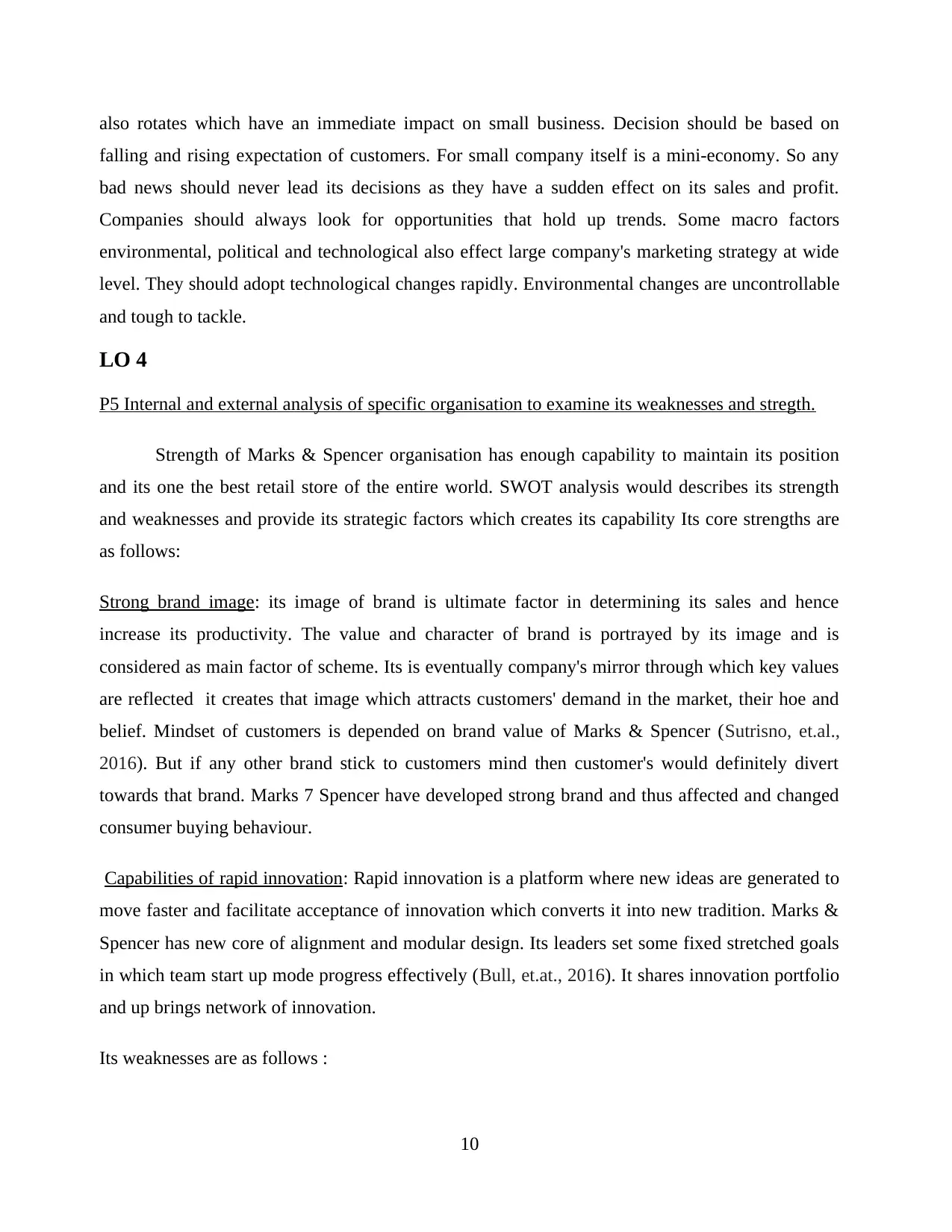
also rotates which have an immediate impact on small business. Decision should be based on
falling and rising expectation of customers. For small company itself is a mini-economy. So any
bad news should never lead its decisions as they have a sudden effect on its sales and profit.
Companies should always look for opportunities that hold up trends. Some macro factors
environmental, political and technological also effect large company's marketing strategy at wide
level. They should adopt technological changes rapidly. Environmental changes are uncontrollable
and tough to tackle.
LO 4
P5 Internal and external analysis of specific organisation to examine its weaknesses and stregth.
Strength of Marks & Spencer organisation has enough capability to maintain its position
and its one the best retail store of the entire world. SWOT analysis would describes its strength
and weaknesses and provide its strategic factors which creates its capability Its core strengths are
as follows:
Strong brand image: its image of brand is ultimate factor in determining its sales and hence
increase its productivity. The value and character of brand is portrayed by its image and is
considered as main factor of scheme. Its is eventually company's mirror through which key values
are reflected it creates that image which attracts customers' demand in the market, their hoe and
belief. Mindset of customers is depended on brand value of Marks & Spencer (Sutrisno, et.al.,
2016). But if any other brand stick to customers mind then customer's would definitely divert
towards that brand. Marks 7 Spencer have developed strong brand and thus affected and changed
consumer buying behaviour.
Capabilities of rapid innovation: Rapid innovation is a platform where new ideas are generated to
move faster and facilitate acceptance of innovation which converts it into new tradition. Marks &
Spencer has new core of alignment and modular design. Its leaders set some fixed stretched goals
in which team start up mode progress effectively (Bull, et.at., 2016). It shares innovation portfolio
and up brings network of innovation.
Its weaknesses are as follows :
10
falling and rising expectation of customers. For small company itself is a mini-economy. So any
bad news should never lead its decisions as they have a sudden effect on its sales and profit.
Companies should always look for opportunities that hold up trends. Some macro factors
environmental, political and technological also effect large company's marketing strategy at wide
level. They should adopt technological changes rapidly. Environmental changes are uncontrollable
and tough to tackle.
LO 4
P5 Internal and external analysis of specific organisation to examine its weaknesses and stregth.
Strength of Marks & Spencer organisation has enough capability to maintain its position
and its one the best retail store of the entire world. SWOT analysis would describes its strength
and weaknesses and provide its strategic factors which creates its capability Its core strengths are
as follows:
Strong brand image: its image of brand is ultimate factor in determining its sales and hence
increase its productivity. The value and character of brand is portrayed by its image and is
considered as main factor of scheme. Its is eventually company's mirror through which key values
are reflected it creates that image which attracts customers' demand in the market, their hoe and
belief. Mindset of customers is depended on brand value of Marks & Spencer (Sutrisno, et.al.,
2016). But if any other brand stick to customers mind then customer's would definitely divert
towards that brand. Marks 7 Spencer have developed strong brand and thus affected and changed
consumer buying behaviour.
Capabilities of rapid innovation: Rapid innovation is a platform where new ideas are generated to
move faster and facilitate acceptance of innovation which converts it into new tradition. Marks &
Spencer has new core of alignment and modular design. Its leaders set some fixed stretched goals
in which team start up mode progress effectively (Bull, et.at., 2016). It shares innovation portfolio
and up brings network of innovation.
Its weaknesses are as follows :
10
Paraphrase This Document
Need a fresh take? Get an instant paraphrase of this document with our AI Paraphraser
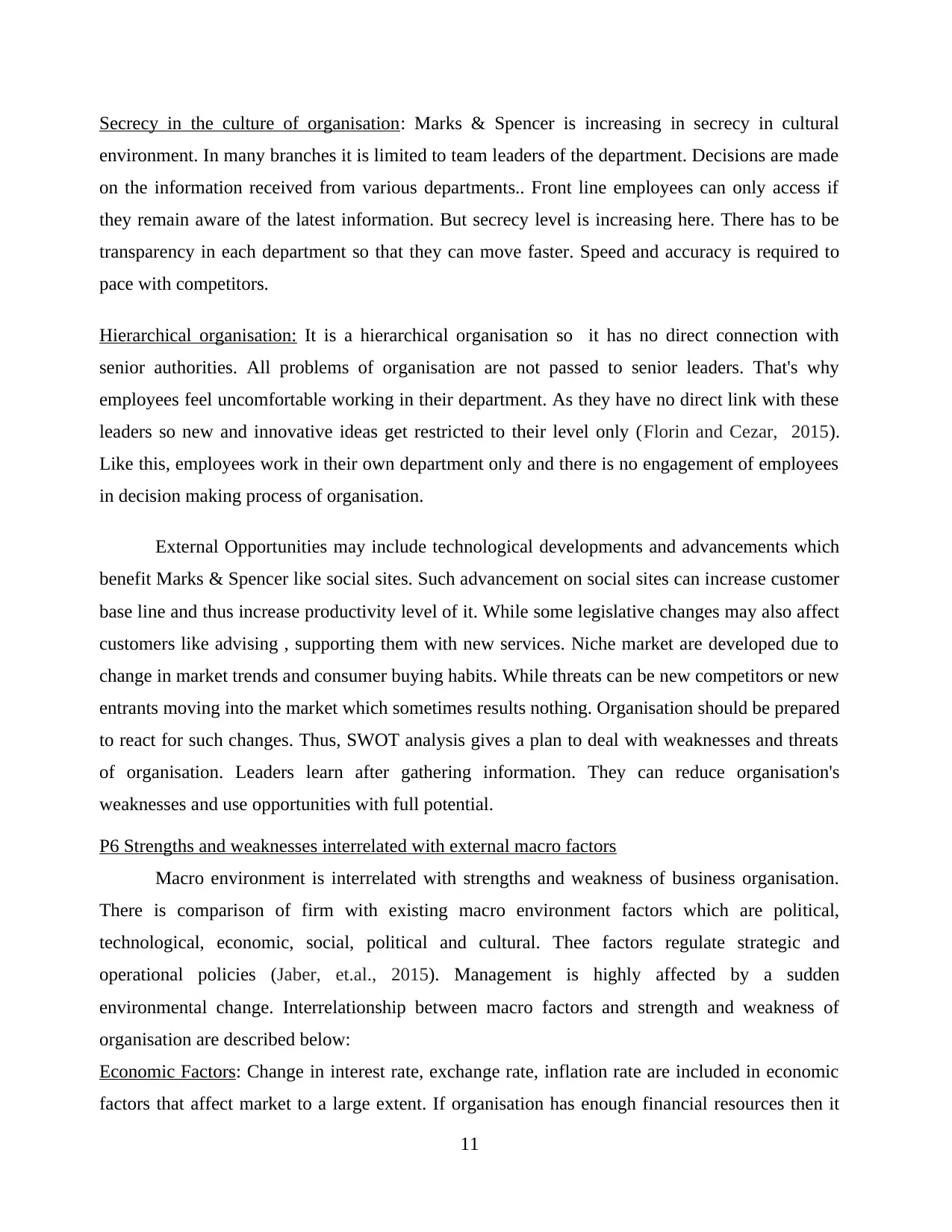
Secrecy in the culture of organisation: Marks & Spencer is increasing in secrecy in cultural
environment. In many branches it is limited to team leaders of the department. Decisions are made
on the information received from various departments.. Front line employees can only access if
they remain aware of the latest information. But secrecy level is increasing here. There has to be
transparency in each department so that they can move faster. Speed and accuracy is required to
pace with competitors.
Hierarchical organisation: It is a hierarchical organisation so it has no direct connection with
senior authorities. All problems of organisation are not passed to senior leaders. That's why
employees feel uncomfortable working in their department. As they have no direct link with these
leaders so new and innovative ideas get restricted to their level only (Florin and Cezar, 2015).
Like this, employees work in their own department only and there is no engagement of employees
in decision making process of organisation.
External Opportunities may include technological developments and advancements which
benefit Marks & Spencer like social sites. Such advancement on social sites can increase customer
base line and thus increase productivity level of it. While some legislative changes may also affect
customers like advising , supporting them with new services. Niche market are developed due to
change in market trends and consumer buying habits. While threats can be new competitors or new
entrants moving into the market which sometimes results nothing. Organisation should be prepared
to react for such changes. Thus, SWOT analysis gives a plan to deal with weaknesses and threats
of organisation. Leaders learn after gathering information. They can reduce organisation's
weaknesses and use opportunities with full potential.
P6 Strengths and weaknesses interrelated with external macro factors
Macro environment is interrelated with strengths and weakness of business organisation.
There is comparison of firm with existing macro environment factors which are political,
technological, economic, social, political and cultural. Thee factors regulate strategic and
operational policies (Jaber, et.al., 2015). Management is highly affected by a sudden
environmental change. Interrelationship between macro factors and strength and weakness of
organisation are described below:
Economic Factors: Change in interest rate, exchange rate, inflation rate are included in economic
factors that affect market to a large extent. If organisation has enough financial resources then it
11
environment. In many branches it is limited to team leaders of the department. Decisions are made
on the information received from various departments.. Front line employees can only access if
they remain aware of the latest information. But secrecy level is increasing here. There has to be
transparency in each department so that they can move faster. Speed and accuracy is required to
pace with competitors.
Hierarchical organisation: It is a hierarchical organisation so it has no direct connection with
senior authorities. All problems of organisation are not passed to senior leaders. That's why
employees feel uncomfortable working in their department. As they have no direct link with these
leaders so new and innovative ideas get restricted to their level only (Florin and Cezar, 2015).
Like this, employees work in their own department only and there is no engagement of employees
in decision making process of organisation.
External Opportunities may include technological developments and advancements which
benefit Marks & Spencer like social sites. Such advancement on social sites can increase customer
base line and thus increase productivity level of it. While some legislative changes may also affect
customers like advising , supporting them with new services. Niche market are developed due to
change in market trends and consumer buying habits. While threats can be new competitors or new
entrants moving into the market which sometimes results nothing. Organisation should be prepared
to react for such changes. Thus, SWOT analysis gives a plan to deal with weaknesses and threats
of organisation. Leaders learn after gathering information. They can reduce organisation's
weaknesses and use opportunities with full potential.
P6 Strengths and weaknesses interrelated with external macro factors
Macro environment is interrelated with strengths and weakness of business organisation.
There is comparison of firm with existing macro environment factors which are political,
technological, economic, social, political and cultural. Thee factors regulate strategic and
operational policies (Jaber, et.al., 2015). Management is highly affected by a sudden
environmental change. Interrelationship between macro factors and strength and weakness of
organisation are described below:
Economic Factors: Change in interest rate, exchange rate, inflation rate are included in economic
factors that affect market to a large extent. If organisation has enough financial resources then it
11
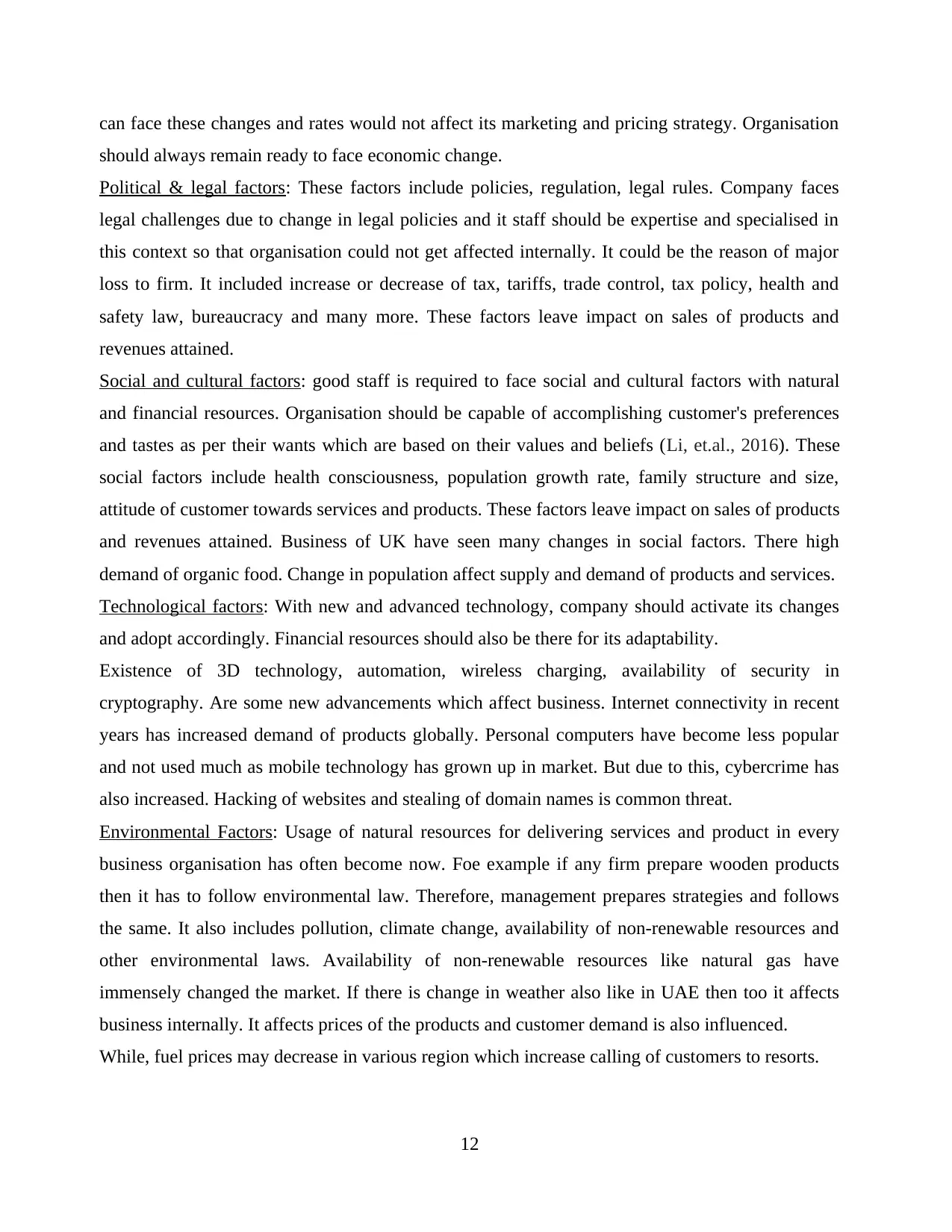
can face these changes and rates would not affect its marketing and pricing strategy. Organisation
should always remain ready to face economic change.
Political & legal factors: These factors include policies, regulation, legal rules. Company faces
legal challenges due to change in legal policies and it staff should be expertise and specialised in
this context so that organisation could not get affected internally. It could be the reason of major
loss to firm. It included increase or decrease of tax, tariffs, trade control, tax policy, health and
safety law, bureaucracy and many more. These factors leave impact on sales of products and
revenues attained.
Social and cultural factors: good staff is required to face social and cultural factors with natural
and financial resources. Organisation should be capable of accomplishing customer's preferences
and tastes as per their wants which are based on their values and beliefs (Li, et.al., 2016). These
social factors include health consciousness, population growth rate, family structure and size,
attitude of customer towards services and products. These factors leave impact on sales of products
and revenues attained. Business of UK have seen many changes in social factors. There high
demand of organic food. Change in population affect supply and demand of products and services.
Technological factors: With new and advanced technology, company should activate its changes
and adopt accordingly. Financial resources should also be there for its adaptability.
Existence of 3D technology, automation, wireless charging, availability of security in
cryptography. Are some new advancements which affect business. Internet connectivity in recent
years has increased demand of products globally. Personal computers have become less popular
and not used much as mobile technology has grown up in market. But due to this, cybercrime has
also increased. Hacking of websites and stealing of domain names is common threat.
Environmental Factors: Usage of natural resources for delivering services and product in every
business organisation has often become now. Foe example if any firm prepare wooden products
then it has to follow environmental law. Therefore, management prepares strategies and follows
the same. It also includes pollution, climate change, availability of non-renewable resources and
other environmental laws. Availability of non-renewable resources like natural gas have
immensely changed the market. If there is change in weather also like in UAE then too it affects
business internally. It affects prices of the products and customer demand is also influenced.
While, fuel prices may decrease in various region which increase calling of customers to resorts.
12
should always remain ready to face economic change.
Political & legal factors: These factors include policies, regulation, legal rules. Company faces
legal challenges due to change in legal policies and it staff should be expertise and specialised in
this context so that organisation could not get affected internally. It could be the reason of major
loss to firm. It included increase or decrease of tax, tariffs, trade control, tax policy, health and
safety law, bureaucracy and many more. These factors leave impact on sales of products and
revenues attained.
Social and cultural factors: good staff is required to face social and cultural factors with natural
and financial resources. Organisation should be capable of accomplishing customer's preferences
and tastes as per their wants which are based on their values and beliefs (Li, et.al., 2016). These
social factors include health consciousness, population growth rate, family structure and size,
attitude of customer towards services and products. These factors leave impact on sales of products
and revenues attained. Business of UK have seen many changes in social factors. There high
demand of organic food. Change in population affect supply and demand of products and services.
Technological factors: With new and advanced technology, company should activate its changes
and adopt accordingly. Financial resources should also be there for its adaptability.
Existence of 3D technology, automation, wireless charging, availability of security in
cryptography. Are some new advancements which affect business. Internet connectivity in recent
years has increased demand of products globally. Personal computers have become less popular
and not used much as mobile technology has grown up in market. But due to this, cybercrime has
also increased. Hacking of websites and stealing of domain names is common threat.
Environmental Factors: Usage of natural resources for delivering services and product in every
business organisation has often become now. Foe example if any firm prepare wooden products
then it has to follow environmental law. Therefore, management prepares strategies and follows
the same. It also includes pollution, climate change, availability of non-renewable resources and
other environmental laws. Availability of non-renewable resources like natural gas have
immensely changed the market. If there is change in weather also like in UAE then too it affects
business internally. It affects prices of the products and customer demand is also influenced.
While, fuel prices may decrease in various region which increase calling of customers to resorts.
12
⊘ This is a preview!⊘
Do you want full access?
Subscribe today to unlock all pages.

Trusted by 1+ million students worldwide
1 out of 19
Related Documents
Your All-in-One AI-Powered Toolkit for Academic Success.
+13062052269
info@desklib.com
Available 24*7 on WhatsApp / Email
![[object Object]](/_next/static/media/star-bottom.7253800d.svg)
Unlock your academic potential
Copyright © 2020–2025 A2Z Services. All Rights Reserved. Developed and managed by ZUCOL.




